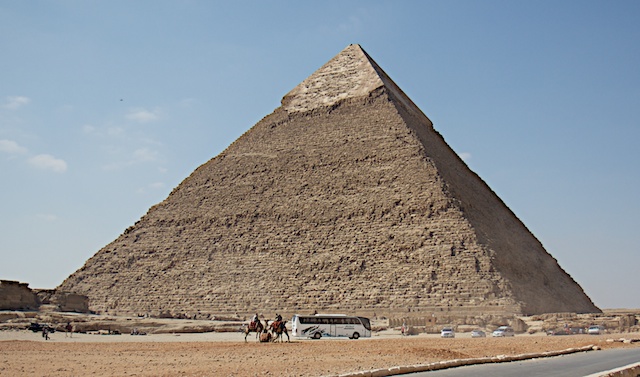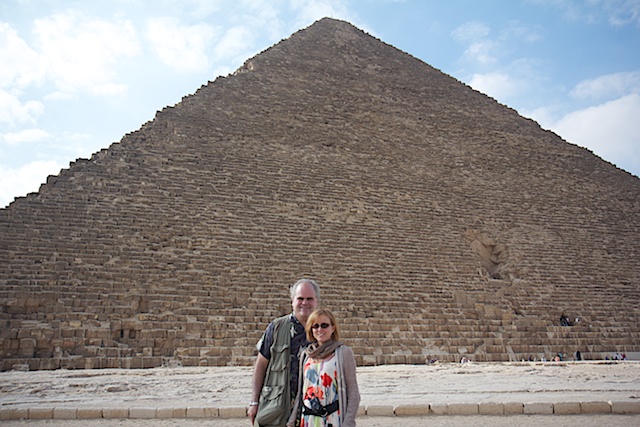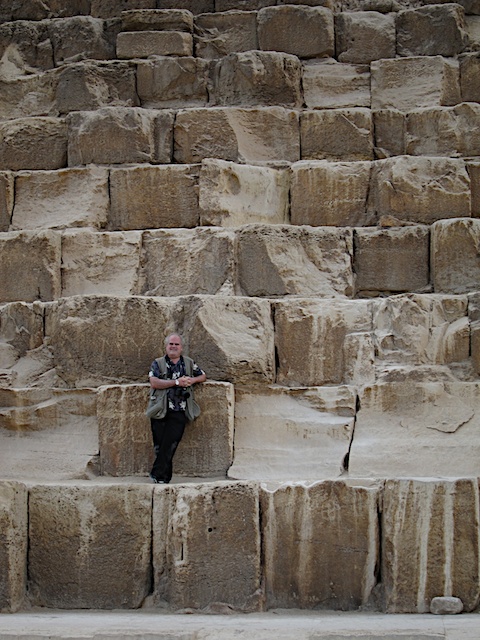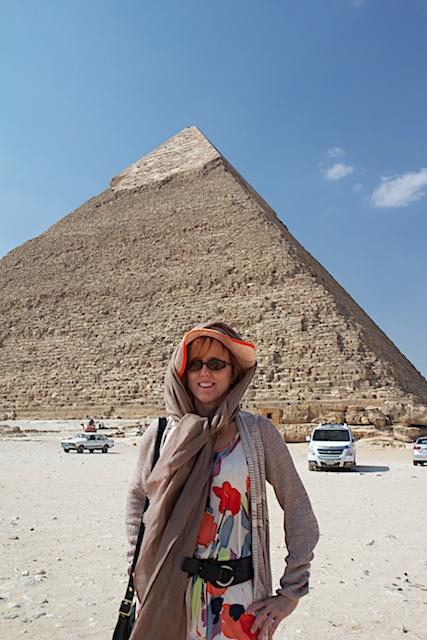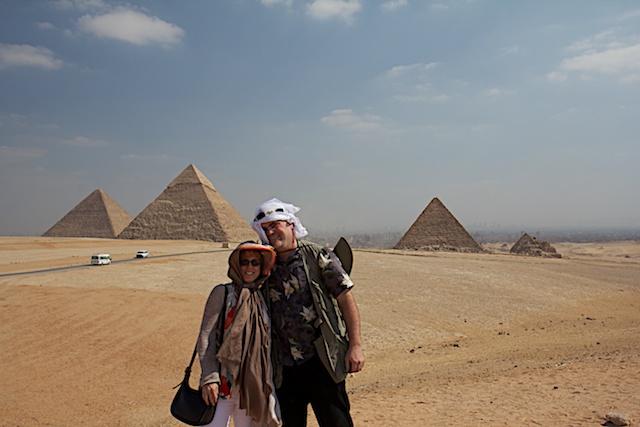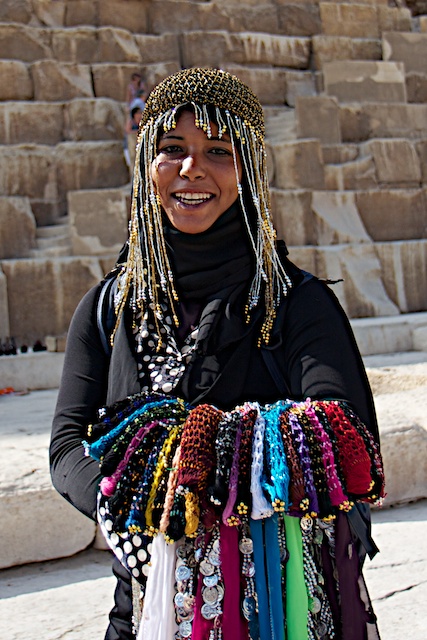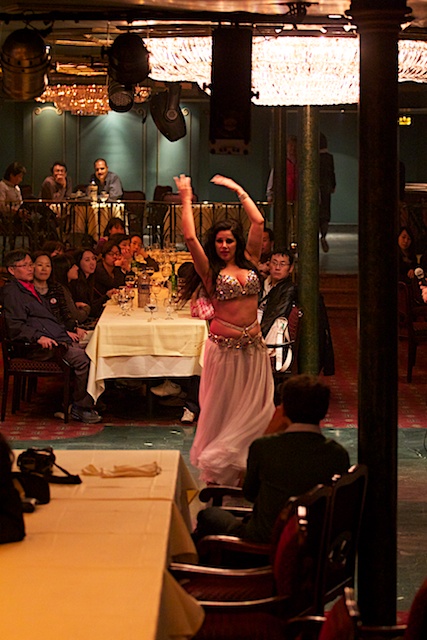You know what’s great? Â This is great.
You know what’s awfully nice, but not quite great? Â This.
You know what Julie and I visited today?
Doesn’t look so big, does it?  But then you look at the buildings in the background of the first picture, or the bus in the foreground of the second one.  Or you look at the number of layers of stone in all of them and take a closer look at the scale and you see this:
And then you’re forced to admit that the Great Pyramid is, well, great. Â I’ll even grant that Khafre’s Pyramid, the slightly-shorter one, is great too.
Here’s a few more pictures of us with pyramids:
That last one is of the people in our tour group.
Here’s our staff: Karima, guide supreme; Hussein, tour organizer and fixer; and Heba, lecturer and knower of interesting things.
Aside from the pyramids, the Giza plateau is chock full of things that are worth seeing. Â There’s the funeral boat found in a pit near the Great Pyramid where it has been waiting for 4500 years:
There’s camels, which are strange looking beasts:
but fun to ride:
And, of course, there’s the Sphinx.
From the time we started planning this trip, I imagined taking a picture of the Sphinx looking over Julie’s shoulder. Â Alas, we were not allowed close enough for the shot that I wanted, but this will do.
My own experience with the Sphinx was a bit more personal. Â Who knew that the Sphinx is a minx?
But I’ve got to say, one of my favorite things on the Giza Plateau is the people you find there. Â Like the vendors selling souvenir trinkets.
My favorite encounter was with a class of kids on a field trip. Â They were swarming past our slower moving group when I asked one boy if I could take his picture. Â He said yes.
Before we were done exchanging names, his friend popped up and insisted that I take his picture too.
The next thing I knew, I was surrounded by the entire class, introducing themselves and insisting on having their picture taken with me:
What a terrific group!
After lunch, we visited the necropolis of Saqqara. Â But first, a little history of pyramids.
The first kings of Egypt were buried in mastaba tombs. Â A mastaba tomb is a stone building that encloses a burial shaft. Â We visited one belonging to a nobleman which contained marvelous reliefs on the walls. Â These were scenes of day-to-day life, including one showing boating on the Nile, including a hippo biting a crocodile’s head, and a line of dancers doing what looked like an acrobatic can-can. Â (No pictures allowed in the tombs, alas.)
But a mastaba tomb is not much to look at from the outside. Â So when it came time to build a tomb for King Djoser in around 2700 BC, his architect decided to try something new.
Imhotep, it should be noted, was quite a guy. Â In addition to being an expert architect and engineer, he was also a pioneer of medicine. Â All these talents were enough that the Egyptians later worshipped him as a god. Â Speaking as an engineer, I have only positive views of deifying engineers.
Imhotep got the idea of building a structure consisting of layers of what look like mastaba tombs. Â Taken together, it resembles a large stone wedding cake with five layers. Â This is the Step Pyramid, and in addition to being the great granddaddy of all the pyramids, it’s also the first monumental building made of stone. Â Anywhere. Â It’s in Saqqara, and we visited it.
Take a look at this column, found in the funerary complex of the Step Pyramid.
It’s not much to look at, a fairly simple column that is not even free standing. Â But it’s one of a set of the oldest stone columns in Egypt, which means it’s possibly the oldest stone column in the world. Â Which makes it a lot more impressive.
That’s another one of Imhotep’s inventions. Â No wonder they deified the guy.
After the Step Pyramid, the architects of King Snefru invented the first true pyramids. Â We’re visiting those on Sunday, so more on them anon. Â Then came the Great Pyramid and the others on the Giza plateau.
After Giza, the Egyptians started getting a bit lazy. Â They decided that, given that they were facing the pyramids with limestone, there wasn’t much point building it out of stone. Â So they switched to using cheaper mud bricks for the body of the pyramid.
But there’s a problem with this. Â Over the years, the limestone facing falls away, or people strip it to use the stone in other projects. Â This isn’t a problem when you have a stone building beneath the facing. Â But if you have built the substructure out of mud brick, you have problems. Â It may only rain three inches a year in Cairo, but that can really add up over 4000 years. Â So those mud brick pyramids have largely decayed into piles of dirt. Â Here’s one:
That’s the pyramid of Teti. Â We went into it, a low crawl to see a stone chamber decorated with hieroglyphs.
After that, it was back to the hotel. Â There was nothing scheduled for the evening, so Julie and I went off on a dinner cruise on the Nile.
There was also a show. Â The belly dancer was good, but the whirling dervish was amazing.
The dervish, wearing a long skirt, spins around with a beatific expression, and the skirt raises and makes him look like a top. Â Then the lights go out, his skirt lights up, and he starts to resemble an amusement park ride at night. Â Good stuff.
And so ended what has been my favorite day in Egypt.


